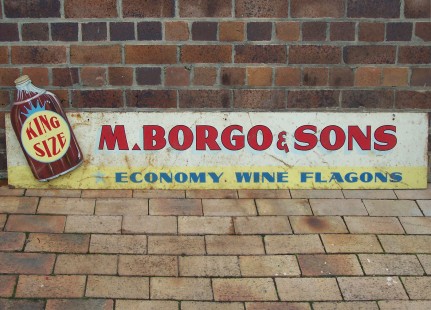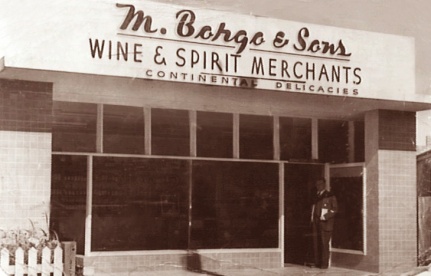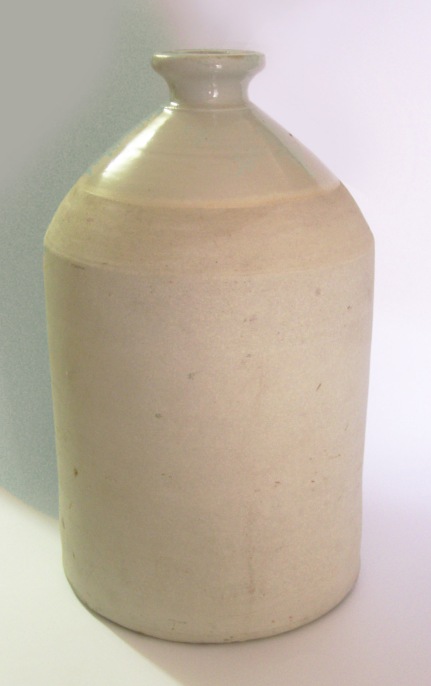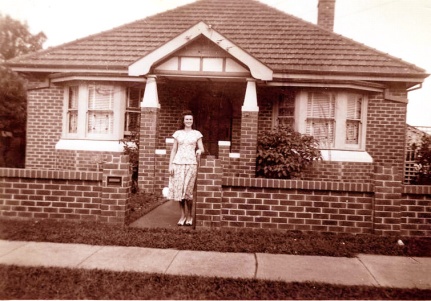Borgo: A Taste of the Continent

Object 300689: M. Borgo & Sons painted metal shop sign, (185cm x 29.5cm), with painted Masonite attached (4cm x 22cm) advertising their economy wine flagons. Image courtesy Illawarra Historical Society.
a
This week I’ve explored some items which I started looking into for the upcoming virtual museum project, being undertaken by Museums and Galleries NSW.
The topic has also been previously touched on by Carol Herben in her ‘Timeless Wollongong’ column in 2012, but hers was more of a passing mention in an overview of various local drink containers in the Museum’s collection.
The museum holds a few items from the Borgo wines business, including a ceramic crock (Object 700176), a retail sign (Object 300689), and a glass flagon (the latter mysteriously can’t be found at this point in time).
People won’t be surprised to learn that, like many Illawarra immigrants, the patriarch of this business hailed from Italy. However they may be surprised to learn that in his background in Australia was the mining industry, before he became a successful retailer.

Mario and Giulia with children Gina, Frank and Derek, in Centrale, Italy, 1928. The Borgos must have taken a trip back to visit family. Image courtesy Wollongong City Council’s Illawarra Images, ref P18/P18296.
a

Object 300689: M. Borgo & Sons painted metal shop sign, (185cm x 29.5cm), with painted Masonite attached (4cm x 22cm) advertising their economy wine flagons. Image courtesy Illawarra Historical Society.
a
Mario Borgo (born in 1897 to Francisca and Angela) migrated to Australia back in 1922; the previous year he had married his sweetheart Giulia née Lievore, a textile worker, at Centrale (presumably this means Italia centrale or just centro, referring to the area of Central Italy). Their daughter Angelina, or Gina as she was known, was born shortly after – and his wife and daughter followed him via sea to the new country later that year.
They moved straight to the Illawarra, and by 1925 they had taken up a cottage at Bellambi Street in Tarrawanna. The couple also had two boys; Frank Sergio was one son born IN 1924. The other son was Dario (known as Derek), who likely came along around 1926.

Mario Borgo washing clothes at a shack in Clifton, 1929. Image courtesy Wollongong City Council’s Illawarra Images, ref P18/P18298.
a

The Borgos In their liquor store circa 1950, likely Crown Street. From left: Gina, Mario, Giulia, and unknown. Image courtesy Wollongong City Council’s Illawarra Images, ref P18/P18301.
a
However there are no birth records and a picture purported to have been taken in Italy in 1928 shows the couple with their three young children. Did they go back to Italy for a time and have children there? Group photos taken in Tarrawanna in 1925 and 1926 show Gina and Frank present, so it seems the answer is no.
Mario began work in Mount Pleasant and Coal Cliff Collieries. A photo of 1929 shows him in Clifton washing clothes on a scrubbing board at a shack, so it is quite likely he also worked at the mine there too. As well as taking up mining, he also had previously worked as a carpenter and cabinetmaker. It was common practice for Italian immigrants who needed work to go into mining on the South Coast during that period, and there was already quite a community in the area by that time.
Mario’s career as a merchant and retailer began by purchasing a wholesale shop that dealt wines and spirits, on Crown Street in 1931. In 1931 he also applied to re-enter Australia having seemingly been in Europe for a short time. I’m unsure why – since he had already made his move to become naturalized in 1929.

Borgo & Sons’ new store and offices, 1956, at the corner of Kenny & Burelli Streets, Wollongong, where Liquorland is today. Image courtesy Wollongong City Council’s Illawarra Images, ref P17/P17778.
a
From 1936 the family lived at 228 Princes Highway, Fairy Meadow in a typical cosy brick bungalow of that period.
With the advent of WWII Mario enlisted and served as a sergeant-major with the Italian Alpine Troop. Making it back in one piece, he continued with his retail business and went on to become Wollongong’s best-known wine merchant. Financial success meant that by the early 1940s he was purchasing property – first in Fairy Meadow in 1941, then Fairlfield NSW in 1943, and another in Wollongong in 1946 from an A. J. Mitchell.
In 1955 he opened a brand new store in Keira Street which was considered the most modern of its kind. Later he also built Wollongong’s first drive-in liquor store, at corner of Burelli and Kenny Street. This is now the site of Liquorland , it was for some time Tosti Cellars’ ‘Cellarbrations’ store. By this time sons Frank and Derek were working with him and the company became ‘M. Borgio and Sons.’ There was still time for leisure activities, and enjoying a few games of bowls, Mario, with Otto Fuimini founded the Fraternity Bowling and Recreation Club in Fairy Meadow in 1953.

Object 700176: M. Borgo ceramic wine crock, probably circa 1930s. Image courtesy Illawarra Historical Society.
a

Object 700176: M. Borgo ceramic wine crock, probably circa 1930s. Image courtesy Illawarra Historical Society.
a
In 1968 his departure on a months-long European tour of wine tasting and Australian wine promotion was a newsworthy event. In 1970, not long before his death, Mario was notified by the Italian Government that he had been awarded an Italian Cavalier Award for bravery and war service.
Mario died 1972, an innovative and respected member of the Wollongong community known as ‘Doc’ Borgio (the reason for this nickname is unknown). The same year son Derek Borgo gave Wollongong a new continental dining experience when he open the city’s first bistro in Market Street; another first for the family. A marketing point was the building’s history; it was the site of Wollongong’s first blacksmith shop H. E. Castle & Sons; the brickwork of some of the walls was original, already 117 years old at the time.

Mario Borgo with flagons of his wine, 1956. He was said to be Wollongong’s first specialist wine and spirit merchant, and its most successful. Image courtesy Wollongong City Council’s Illawarra Images, ref P17/P17779.
a

This brick house at 228 Princes Highway, Fairy Meadow, was the Borgo family home from 1936 through to 1983. Image courtesy Wollongong City Council’s Illawarra Images, ref P18/P18307.
a
Around 1978 the family sold the business for half a million dollars, and the following year Derek Borgo branched out into the hotel industry when he purchased The Harp. He also had involvement in Lake Illawarra and Balgownie Hotels. He was later, in the 1990s, president of the Balgownie Businessmen’s Club. Frank moved away from the area; and Giulia stayed a local for the remainder of her life, passing away in 1984.
People can say what they like about immigrants, but the Borgo wine story is an exemplary tale of a successful business brand built by foreigners who came to this country with a couple of suitcases, a strong work ethic, dreams of a better life – and succeeded in making a contribution.
a
a